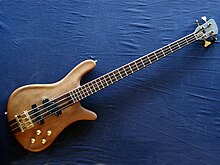Design similarity to Spector NS-Basses
It was well documented that the first versions of the Streamer were near exact copies of the NS-Bass. The Spector NS-Bass was designed by Ned Steinberger for Stuart Spector in 1977, five years before Warwick was formed.
In the May 2012 article titled "Meet Your Maker: Hans Peter Wilfer of Warwick", an interview with Warwick founder and CEO in Bass Player , the following history is given explaining Wilfer's decision to make copies of the highly sought-after Spector NS-Bass: "'We didn’t see any reason to build Fender copycats, which players could get easily and cheaply from Asia, so we decided to focus only on high-end, innovative instruments.' In the mid ’80s, the Spector NS was tracking well in the U.S., but these basses proved hard to come by in Europe. H.P. saw that problem as a potential solution for the direction of his company and took up the task of designing his own version of this popular, ergonomically friendly instrument. That venture resulted in Warwick’s first widely successful instrument: the Streamer Stage I." [2]
At the annual Musikmesse Show (Frankfurt, Germany) in 1985, Stuart Spector became aware that a new German-based company was producing exact copies of his now famous NS-Bass. Spector, along with Ned Steinberger, confronted Hans Wilfer and he agreed to pay a licensing fee to both Spector Guitars and Ned Steinberger in return for being able to continue to produce the Streamer without legal action. [3]
Shortly after this agreement was reached, Spector was sold to Kramer Guitars. The new owners had no interest in pursuing Warwick to enforce the licensing agreement and Warwick continued to make the Streamer without any consequence.
In 1990, Kramer became insolvent and filed for bankruptcy. In the wake of their financial failure, Stuart Spector formed Stuart Spector Design, LTD. in 1992. In 1997 after a lengthy court battle, Stuart Spector was awarded the trademark and copyrights to Spector and threatened to sue Warwick to enforce the 1985 license agreement. [3]
The pending litigation was eventually dropped because Warwick had changed the Streamer design and it was no longer an exact copy of the NS-Bass. In time, Warwick has evolved the design of the Streamer while Spector has sought to preserve the classic elements of the NS-Bass.

The guitar is a fretted musical instrument that typically has six strings. It is usually held flat against the player's body and played by strumming or plucking the strings with the dominant hand, while simultaneously pressing selected strings against frets with the fingers of the opposite hand. A plectrum or individual finger picks may also be used to strike the strings. The sound of the guitar is projected either acoustically, by means of a resonant chamber on the instrument, or amplified by an electronic pickup and an amplifier.
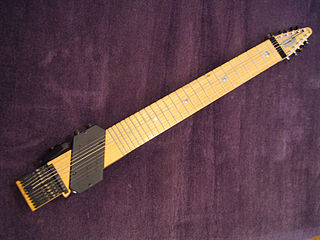
The Chapman Stick is an electric musical instrument devised by Emmett Chapman in the early 1970s. A member of the guitar family, the Chapman Stick usually has ten or twelve individually tuned strings and is used to play bass lines, melody lines, chords, or textures. Designed as a fully polyphonic chordal instrument, it can also cover several of these musical parts simultaneously.
Warwick is a German bass guitar manufacturing company. Warwick basses were originally a premium brand offering a small range of models built from high quality and exotic tonewoods. The company also produces valve and FET amplifiers, speaker cabinets, bass guitar strings, and is the owner of the Framus trademark. Their headquarters and custom shops are located in Markneukirchen, Shanghai, and Nashville.
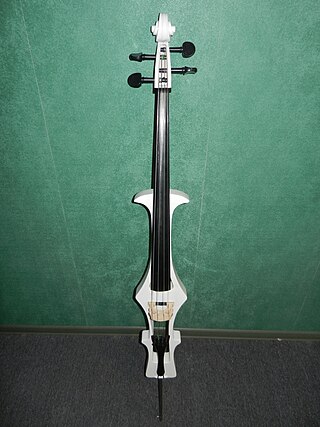
The electric cello is a type of cello that relies on electronic amplification to produce sound. An acoustic cello can be fitted with a bridge or body mounted contact pickup providing an electric signal, or a built-in pickup can be installed. A few pickups work by other principles like magnetic coil guitar type needing steel strings to work, or by an unusual pickup system employing the string itself as a linear pickup element, thus avoiding any modification of tone-producing parts on an acoustic cello.

The Fender Precision Bass is a model of electric bass guitar manufactured by Fender Musical Instruments Corporation. In its standard, post-1957 configuration, the Precision Bass is a solid body, four-stringed instrument usually equipped with a single split-coil humbucking pickup and a one-piece, 20-fret maple neck with rosewood or maple fingerboard.
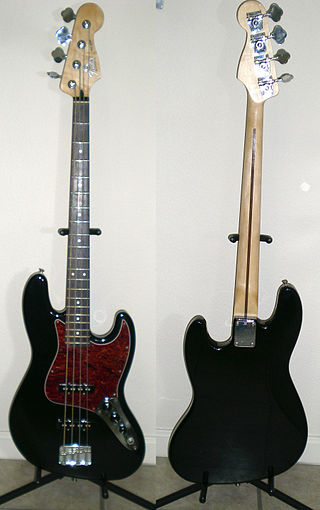
The Fender Jazz Bass is the second model of electric bass created by Leo Fender. It is distinct from the Precision Bass in that its tone is brighter and richer in the midrange and treble with less emphasis on the fundamental frequency. The body shape is also different from the Precision Bass, in that the Precision Bass has a symmetrical lower bout on the body, designed after the Telecaster and Stratocaster lines of guitars, while the Jazz Bass has an offset lower bout, mimicking the design aesthetic of the Jaguar and Jazzmaster guitars.

The Spector Musical Instruments is an American manufacturer of instruments. Spector produces electric guitars, acoustic and electric bass guitars; however, it is best known for its solid-body electric bass guitars, particularly the NS-2. The company was founded in Brooklyn, New York by Stuart Spector in 1976. It's current headquarters are in Long Island, New York.
Steinberger is a series of distinctive electric guitars and bass guitars, designed and originally manufactured by Ned Steinberger. The name "Steinberger" can be used to refer to either the instruments themselves or the company that originally produced them. Although the name has been applied to a variety of instruments, it is primarily associated with a minimalist "headless" design of electric basses and guitars.
Ned Steinberger is an American creator of innovative musical instruments. He is most notable for his design of guitars and basses without a traditional headstock, which are called Steinberger instruments. He also has a line of electric basses and string instruments through his company called NS Design and was also the designer of the first ever Spector bass, the NS. In addition, Ned and Emmett Chapman, creator of the Chapman Stick, collaborated on the creation of the NS Stick, a guitar/bass "multi-mode" instrument sold by Stick Enterprises.

A headstock or peghead is part of a guitar or similar stringed instruments such as a lute, mandolin, banjo, ukulele and others of the lute lineage. The main function of a headstock is to house the tuning pegs or other mechanism that holds the strings at the "head" of the instrument; it corresponds to a pegbox in the violin family. At the "tail" of the instrument the strings are usually held by a tailpiece or bridge. Machine heads on the headstock are commonly used to tune the instrument by adjusting the tension of strings and, consequently, the pitch of sound they produce.

Kramer Guitars is an American manufacturer of electric guitars and basses. Kramer produced aluminum-necked electric guitars and basses in the 1970s and wooden-necked guitars catering to hard rock and heavy metal musicians in the 1980s; Kramer is currently a division of Gibson Guitar Corporation.
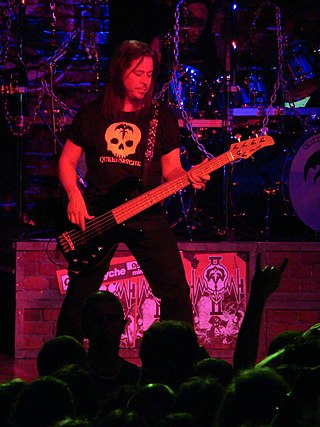
Eddie Jackson, also known as EdBass and One Take, is an American bass guitarist for the progressive metal band Queensrÿche, which he co-founded in 1982.
The Fender Bullet was an electric guitar originally designed by John Page and manufactured and marketed by the Fender Musical Instruments Corporation. It was first introduced as a line of "student" guitars to replace the outgoing Mustang and Musicmaster models.
Electric guitar design is a type of industrial design where the looks and efficiency of the shape as well as the acoustical aspects of the guitar are important factors. In the past many guitars have been designed with various odd shapes as well as very practical and convenient solutions to improve the usability of the object.

The Fender Aerodyne Jazz Bass is an electric bass guitar created by Fender and was first introduced at Winter NAMM 2003. In 2022, Fender decided after nearly 20 years of production that the Aerodyne has been discontinued.

Duesenberg is a brand for electric string instruments founded in 1986 and located in Hannover, Germany. The headquarter is in Hannover, Germany, they are known for using a Plek machine for the levelling of frets and setup. The actual place for production of guitar bodies and necks have never been revealed by Duesenberg e.g. by showing a factory Tour video.
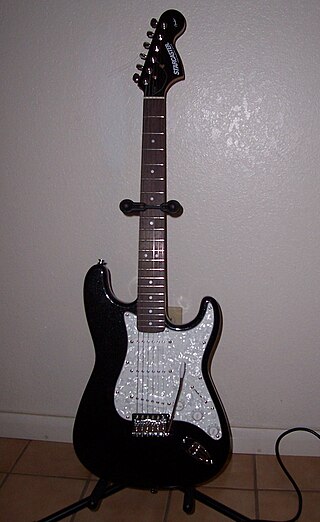
Starcaster by Fender is a range of instruments and accessories aimed at students and beginners, marketed by the Fender Musical Instruments Corporation from the early 2000s until at least 2011. As of April 2018, no products were being marketed under this brand.
Warwick Corvette is a line of bass guitars manufactured by the German Warwick bass company. The Corvette is one of the most popular Warwick basses. Among the more distinctive Corvette players are Erlend Caspersen and Hansford Rowe. Despite its similarity in woods and aesthetics to the Thumb bass, it has a drastically different feel, tone, and ergonomics. It is one of the most distinctive Warwick basses.
Dolphin is a bass guitar manufactured by the Warwick company from Markneukirchen, Germany. The "D-bass" earned its fame for its somewhat eccentric design.
Blade Guitars is a manufacturer of electric guitars and bass guitars founded by luthier Gary Levinson in 1987. Levinson had been repairing guitars since 1964 and, in 1977, during his graduate studies at the University of Basel, Switzerland, he founded Guitars by Levinson. Using the experience he gathered from his work, he decided to start Blade Guitars in 1985. By 1986, he was refining the idea of a line of guitars based on the concept he defines as "Classic Design, Creative Technology"; at this time, he was also determining the features that would characterize his range of guitars. In January 1987, a manufacturing deal was reached for the production of the guitars. Blade Guitars made their debut in October 1987, at the music show of Tokyo. Their presentation at the Frankfurt Musikmesse in 1988 signalled their European launch.
